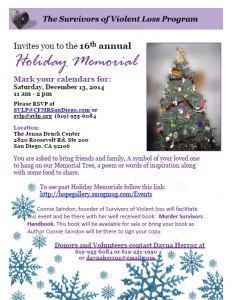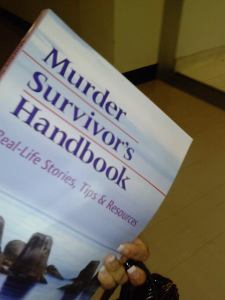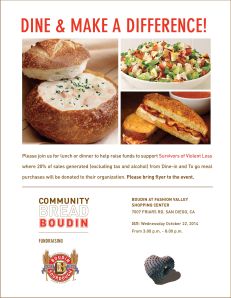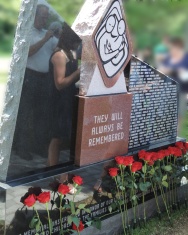You are currently browsing the tag archive for the ‘bereavement’ tag.
Violent Loss Resources Newsletter, August 1, 2016
News you can use … collected for you in July. (Scroll down to see all)
Contents will vary somewhat month to month, as we close out this month, our contents include:
Topic of the Month: Prosecuting the Case: Survivor Voices
Question of the Month: What happened in your case?
Quote
News: Two Day Conference 2017: Traumatic Grief after Violent Dying
Inspiration: “Not Forgotten” Project in Chicago contains photos and interviews
Resource of the Month: Victim Law
What you missed last month
Topic of the Month: Chapter Seven, Prosecuting the Case: The importance and complexity involved in this topic is large enough that this topic will continue next month as well. This month the focus will be on Survivor Experiences.
Excerpts from Murder Survivors Handbook 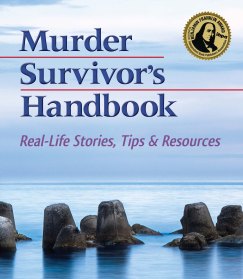
Here are what some Survivors have to say about this topic:
The FBI had a prime suspect in my parents’ deaths—my younger brother. They wanted to prosecute, but the U.S. attorney’s office refused, saying that without bodies, with little forensic evidence, and having an unreliable witness (my youngest sister, who failed two lie-detector tests and vowed to lie in court), that the odds of getting a guilty verdict were too low to risk incurring jeopardy. (Harrier)
When the case stalled, I met with the U.S. attorney assigned to the case. He explained why there would likely be no prosecution, no trial—the case was circumstantial; there were no bodies; there was little forensic evidence; and my sister was not a reliable witness. He did not want to risk incurring jeopardy by losing the case. (Harrier)
…Often it will feel like it is more about the system than it is about justice. It will seem like every consideration is being given to the Defense, on behalf of the Defendant….(Valeria)
Our charges were worked out behind closed doors with input from the Judge. We were advised up front that the justice system did not allow tailoring charges to increase the available sentencing options. We were given a voice only in the crafting of the plea offers, and then it was advisory in nature. We did, however, feel that the State took into account our perspective and the degree of concurrence we expressed was communicated to the judge at sentencing. ( JJ )’
It was a time when our private and public self felt so disconnected, and the hard work we had put into managing our emotions and grief was challenged on a regular basis throughout the trial. (Valeria)
I was told that my telling of domestic abuse was not relevant to the case, but I feel that it was the reason my sister was murdered; because I left my abusive boyfriend, and he couldn’t find me, so he found my sister and murdered her.(Kaila)
When court comes into session, they ask if the judge, the recorder, the prosecutor, the defendant, and the defendant’s attorney is present. They don’t even care or ask if the victim’s family is there. In a lot of cases, I think the defense would be very happy if we were not there. (Kaila)
Twenty-eight years later an arrest was made. After two years of court hearings, a plea agreement was reached for 2nd degree murder. (Halia)
Means, Motive, and Opportunity
The prosecution of a case does not mean motive has to be proven, but the jury does want to know why it happened. Did the defendant have the means, motive, and opportunity to do what he or she is charged with? In our Survivor Writer stories, some of the motives they believe were:
Marina: Oldest motive in the book. Dad planned to end his relationship with his abusive girlfriend, and she was enraged at the loss of a wealthy man to support her lifestyle! …
Harrier: He got caught doing something wrong.
Rose: Prevent having his life disrupted by his son’s existence; it would ruin him . . . child support was secondary.
Kaila: “Revenge.” How dare I leave the man that loved me. He Murdered my sister because I left him.
Yvonne: Random act, opportunity, found someone alone and vulnerable.
Mary: I do personally feel that these 6 teens were stupid and immature. I believe they were bored and thought it was okay to get their kicks that night by beating someone up and causing someone an injury….
Question of the Month – What happened in your case? Subscribe now … and follow up to let us know your thoughts by adding your comments about anything in this article.
Quote: Though you can never really be prepared for the unique challenges that will come your way, we hope that by relating our experiences and what we learned in our journey … you will gain insight and confidence by which to navigate the process, should you ever have to. (Valeria)
News: Two Day “Traumatic Grief after Violent Dying” Conference being planned for April 8 & 9, 2017 in San Diego, CA. Sponsors include Ted Rynearson, MD Virginia Mason Medical Center, and Sid Zisook, MD; University of California, San Diego. Planning Committee includes Connie Saindon, Founder of Survivors of Violent Loss; Ilanit Young, San Diego VA Center; Linda Pena, Director of S.D.DA’s Victim Assistance Center; Charles Nelson, Trauma Recovery Center; Kathleen Barnum, Elizabeth Hospice; Mary Edwards, Victim Assistance Coordinating Council with generous financial support from Carmela Caldera. *Mark your calendar.
Inspiration: Not Forgotten: Chicago Street Memorials. Journalist Ann-Marie Cusac and former Emergency Room MD Thomas Ferrella have teamed up to produce interviews and photography for a show at the Cage Gallery 18 S. Michigan Ave., Chicago running from September 29- December 3rd, 2016. Here is a link for more information for you poster
Resource of the Month: Victim Law: https://www.victimlaw.org/
Victim Law is a searchable database of victims’ rights legal provisions including federal, state, and territorial statutes, tribal laws, state constitutional amendments, court rules, administrative code provisions, and summaries of related court decisions and attorney general opinions.
Victim Law currently contains legal provisions relating to the following 10 basic rights of crime victims:
- The right to attend and be present at criminal justice proceedings;
- The right to be heard in the criminal justice process, including the right to confer with the prosecutor and submit a victim impact statement at sentencing, parole, and other similar proceedings;
- The right to be informed of proceedings and events in the criminal justice process, including the release or escape of the offender, legal rights and remedies, and available benefits and services, and access to records, referrals, and other information;
- The right to protection, including protection from intimidation and harassment;
- The right to privacy;
- The right to apply for crime victim compensation;
- The right to restitution from the offender;
- The right to the expeditious return of personal property seized as evidence whenever possible;
- The right to a speedy trial and other proceedings free from unreasonable delay; and
- The right to enforcement of these rights and access to other available remedies.
What you missed last month:
Topic of the Month: The Criminal Justice Process
Question of the Month- What tips do you have?
News: Orlando
Inspiration: I’ll cry again
Book Resource: Accidental Truth
Like us on Facebook:
Subscribe now … and follow up to let us know your thoughts by adding your comments about anything in this article.
Violent Loss Resources Team — Contact us
Connie Saindon: csaindon@svlp.org
Larry Edwards: larry@larryedwards.com
What do a nurse, Director of Families and Friends of Murder Victims, a teacher, a Chaplin, Directors of Restorative Justice, therapist, missionary and survivor have in common? They are members of a trained team in San Bernardino, and they need our support.
They have prepared for the past three years to be ready — to be ready for their work and support survivors of violent loss. Many are driven to make a difference from their own grief stories to show how they have survived. Many continue a career in aiding humanity, all committed to knowing how they can help survivors after murder and other violent deaths.
It was an honor to be among such incredible people again the week just before Thanksgiving. They had all given up there weekend to spend three days together learning more about The Journey, a ten week support group.
2013
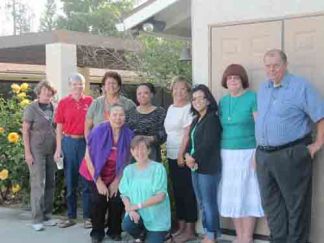
2014
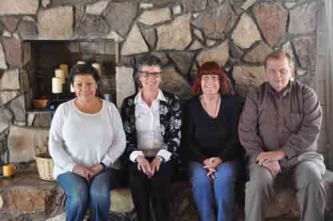
2015
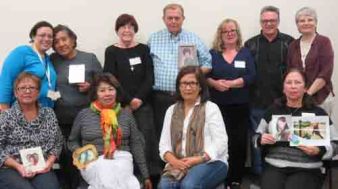
They have formed a team that will support each other as they take the tools that The Journey provides them in working with others with the ideas and support from the evidence-based model Restorative Retelling by Edward Rynearson, MD.
The Journey: Learning to Live with Violent Loss, with its accompanying audio recordings, will be released December 8, 2015. This is an updated version of the book published in 2008 by Connie Saindon. Three more real stories have been added along with more examples of Survivor Heroes, Missions and support-group guidelines. The book will be available on Amazon.com and other retail outlets, along with her other book, the award winning Murder Survivors Handbook: Real-Life Stories, Tips and Resources.
To support the San Bernardino Team, contact Anna Hamilton, Assoc. Director of Restorative Justice at 909-475-5474 or ahamilton@sbdiocese.org.
For more information about the books and support-group training, contact Connie Saindon, MFT, Founder of Survivors of Violent Loss and Violent Loss Resources, at 858-699-7700 or connie.saindon@gmail.com
Links
- The Journey: Learning to Live with Violent Death
- Murder Survivor’s Handbook: Real-Life Stories, Tips & Resources
- Violent Loss Resources
Connie Saindon
Murder Survivors Handbook goes to court!
Connie Saindon
It’s gratifying to see that people are getting value from the Murder Survivor’s Handbook that a group worked so hard to produce. This is exactly what Survivor Writers had hoped!
Here’s a comment from a grieving mother who currently spends her days in a courtroom:
I’m in the middle of pre-trial. I take this book with me to court; I read it as I am there when I run into a problem or hear something I don’t understand. I have it with me at all times. As I read the stories it helps me see this is exactly how I am feeling during pre-trial and I am careful in everything I do there. I encourage everyone who is going to court to buy this even before then. When my son died, I didn’t understand why detectives were not telling me anything. I wondered if they were even doing anything; during pre-trial I heard just how hard they were working on the investigation. I keep this book close, still reading it. Thank you to everyone who took part in making this book happen.
Many co-victims of murder asked me to write this book so those who must make this tragic journey will have a helping hand. We are all saddened that there is a need for this book, but I am happy that we were able to pull this together in the interest of helping others.
And here’s a recent comment from the producer of a prime-time TV show:
As a network news producer who focuses on violent crime, I meet families all the time who have just gone through the worst thing ever and then have to deal with a world of cops, prosecutors, media that they’ve never dealt with before. The Murder Survivor’s Handbook is a great resource. It’s something I will share with families I meet in the future. It’s great that you have taken the time to put down on paper what you’ve learned through your own tough journeys.
—Susan Leibowitz. Producer, Network News
Murder Survivor’s Handbook helps family members adapt to the aftermath of murder. The book was formally released on September 25, 2014, to coincide with the National Day of Remembrance for Murder Victims.
If you know someone who has had a loved one murdered, please tell them about this book.
Links
- Murder Survivor’s Handbook: Real-Life Stories, Tips & Resources • Facebook: Murder Survivor’s Handbook • Website: Survivors of Violent Loss • Blog: Survivors of Violent Loss
- Dare I Call It Murder? — A Memoir of Violent Loss • Facebook: Dare I Call It Murder?
News: September 26, 2014, Maine National Day of Remembrance of Murder Victims
Sister Nina Hodgkins attended the Maine Day of Remembrance for Murder Victims as proclaimed by Maine Governor Paul LePage. The new memorial wall for the state of Maine was established by the Maine Chapter of Parents of Murdered Children just last year. I was fortunate to be able to attend their ceremony with Nina last summer. Nina has been the lead for our family in getting our sister’s name Shirley “Tiny” Dianne Rollins on the new memorial wall. Other murder victims our family has known are Frank Williams and Chet Lee Worthington. Their names are included in this remembrance.
 The San Diego effort for this day of remembrance is the launching of Murder Survivors Handbook. This two and half year project is both heart wrenching and heartfelt. The book includes the commitment of many survivors who wanted to help new comers to have more information and resources than they had. Positive reviews continue to come in. A real lesson as well to those who wonder what it is like for folks to have this type of loss. It has been indeed an honor to work with so many and we all hope that it will make a difference in learning to bear this unspeakable crime.
The San Diego effort for this day of remembrance is the launching of Murder Survivors Handbook. This two and half year project is both heart wrenching and heartfelt. The book includes the commitment of many survivors who wanted to help new comers to have more information and resources than they had. Positive reviews continue to come in. A real lesson as well to those who wonder what it is like for folks to have this type of loss. It has been indeed an honor to work with so many and we all hope that it will make a difference in learning to bear this unspeakable crime.
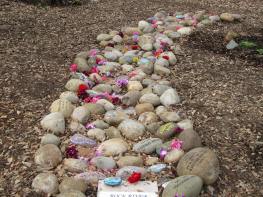 River of Remembrance held its annual event to coincide with this special day as well here in San Diego. It is held the Saturday before the National Day (September 25) to increase the ability for more to attend. Survivors rarely have opportunity to talk about their loved one’s life, and this event facilitates them doing so. By having rocks bearing their names and placed in a “river” and T-shirts to paint a memory of their loved one they want us all to know about, too. They would not want to be remembered just as murder victims. This event was created by the Founder of Survivors of Violent Loss, Connie Saindon, and held at the Crime Victims Oak Garden with permission of the Cara Knott family. Many agencies co-sponsor this event every year.
River of Remembrance held its annual event to coincide with this special day as well here in San Diego. It is held the Saturday before the National Day (September 25) to increase the ability for more to attend. Survivors rarely have opportunity to talk about their loved one’s life, and this event facilitates them doing so. By having rocks bearing their names and placed in a “river” and T-shirts to paint a memory of their loved one they want us all to know about, too. They would not want to be remembered just as murder victims. This event was created by the Founder of Survivors of Violent Loss, Connie Saindon, and held at the Crime Victims Oak Garden with permission of the Cara Knott family. Many agencies co-sponsor this event every year.
It’s official. Murder Survivor’s Handbook: Real-Life Stories, Tips & Resources is launched and available for purchase at Amazon.com, Barnes & Noble online, and through traditional retail outlets.

Written by Connie Saindon, MA, MFT—along with many other voices—the book is being formally released on Sept. 25, 2014, to coincide with the National Day of Remembrance for Murder Victims. [Read Connie’s essay: Remembering Our Murdered Loved Ones.]
“Many survivors and co-victims of murder asked me to write this book so those who must make this tragic journey will have a helping hand,” Saindon says. “I am saddened that there is a need for this book, but I am happy that we were able to pull this together in the interest of helping others.”
When a loved one is murdered, the survivors—the co-victims—are plunged into a head-spinning world of traumatic grief, criminal investigation, criminal justice, and the long-term consequences of violent loss. Sensational news coverage may compound the trauma of their loss.
Murder Survivor’s Handbook: Real-life Stories, Tips & Resources helps these survivors wend their way on this overwhelming journey they never chose to take.
Saindon’s professional as well as personal experience have given her a unique perspective that few others have. Not only did she learn first-hand about criminal death following the murder of her sister, she learned that she is a Survivor in every sense of the word. However, she also found that little was known about the impact of murder on survivors.
This book fills that void for the survivors, the co-victims of murder. It provides information, resources, and strategies for learning to live with the aftermath of a homicide, including safety issues, dealing with the criminal justice system, addressing the news media, and coping with traumatic grief, while preserving the memory of a loved one.
Also in the book, Survivor Writers describe their own experiences and, through their tips and suggestions, lend a helping hand to those who follow in their footsteps.
The book also encourages the readers to write down their own feelings and experiences as they take this journey no one ever wants to take, but in which they had no choice.
The Foreword to the book is written by Edward K. Rynearson, MD, Medical Director, Separation and Loss Services Program, Virginia Mason Medical Center in Seattle, WA, and the author of Retelling Violent Death.
In prerelease sales, the book became a Hot New Release at Amazon.com in the Criminal Procedure Law category, and climbed onto Amazon’s Best Seller list in that category as well.
All proceeds from the sale of the book go to the Survivors of Violent Loss Program to provide books to those who may need assistance.
For bulk purchases of the book, please contact the author or Wigeon Publishing.
Praise for the book:
This handbook is the absolutely perfect tool for survivors of homicide victims and those professionals who work to support them. Through the voices of survivors, the stark realities of learning to live with homicide are clearly exposed. The incredible depth of sorrow, daunting financial impact and the long-term challenges that survivors face are effectively presented. The wealth of information contained in this handbook needs to be on the bookshelves of everyone who interacts with survivors of homicide.
—Carol Gaxiola, mother of Jasmine Gaxiola
Director/Victim Advocate, Homicide Survivors, Inc.
The book is rich in content. It is the banquet of life-sustaining information that I did not have 15 years ago.
—Marina, Survivor/Co-victim
This is exactly the book I would have loved to have had so I wouldn’t have made so many mistakes; I would have had some idea how this entire process works.
—Dayna Herrroz, Survivor/Co-victim
Peer Advocate/Violent Loss
Details:
• Nonfiction: Death, Grief, Bereavement
• Publisher: Wigeon Publishing
• Wholesale distribution: Ingram
• Size, print edition: 8.5 x 11
• Pages: 244
• Formats:
• paperback; ISBN: 978-0-9896913-0-7; $19.95
• e-book: Kindle, iBooks, Nook, Kobo, etc.; $7.99 (to be released in October)
About the Author
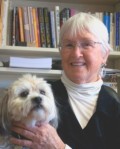 Connie Saindon is a licensed Marriage and Family Therapist and among the few specialists in the field of violent death bereavement. She is the founder of the nonprofit Survivors of Violent Loss Program in San Diego, which began at the University of California-San Diego outpatient clinic in 1998. Her commitment to violent loss bereavement is related to the murder of her sister, aged 17, in 1961.
Connie Saindon is a licensed Marriage and Family Therapist and among the few specialists in the field of violent death bereavement. She is the founder of the nonprofit Survivors of Violent Loss Program in San Diego, which began at the University of California-San Diego outpatient clinic in 1998. Her commitment to violent loss bereavement is related to the murder of her sister, aged 17, in 1961.
She is author of The Journey: Ten Steps to Learning to Live with Violent Death (2008), an adaption of the Restorative Retelling Model for adult self-help and paraprofessionals. She also is a contributing author of Violent Death, Resilience and Intervention Beyond the Crises (2006).
When not pursuing her professional interests, Saindon may be found kayaking in the Atlantic or Pacific oceans, skiing, walking her dog, or taking photographs. A native New Englander, Saindon splits her time between Boothbay, ME, and San Diego, CA.
Contact
For additional information or to schedule an interview:
Connie Saindon
858-699-7700
csaindon@svlp.org
Learn more at: Murder Survivor’s Handbook: Real-life Stories, Tips & Resources
By Connie Saindon
Murder. It’s a fact of life that never goes away. Nor does murder’s impact on the survivors: those who must deal with a horrific new reality in their lives.
On Sept. 25, the National Day of Remembrance of Murder Victims, we will be reminded of this fact as survivors gather to memorialize their murdered loved ones.
Crime rates have dropped in major cities nationwide. Nonetheless, there are roughly 15,000 homicides in the U.S. each year, according to government agencies. The FBI Crime Clock estimates one person is murdered in the United States every 35.6 minutes. These statistics do not include suicide or violent deaths due to negligence or catastrophe.
In San Diego County, the murder rate in 2013 fell to 70 homicides from 110 in 2012. Even so, anything above zero is unacceptable.
Murder often gets sensational headlines in news coverage, but the survivors and the challenges they face in the aftermath of murder typically get short shrift. Yet, the murder of a loved one is a death that no one “gets over”; there is no closure. Seven to ten people are seriously impacted by each violent death, and this “collateral damage” accumulates incrementally each year. There is a potential of 150,000 murder survivors impacted each year, meaning that today millions of Americans live under this shadow of murder and violent death.
For most people, it happens to someone else, to someone else’s mother or father, son or daughter, sister or brother. Until it happens to them. Suddenly, following that phone call or knock on the door, the survivors—the co-victims—find themselves in a mind-numbing whirl of disbelief and chaos. Their world crumbles around them as they have to not only deal with their grief, but the criminal justice system, an intrusive news media, and perhaps a life-time of parole hearings. They have a new and public “murder” identity. Who they were before is changed forever.
Survivors’ questions are many: Is this true? Who did this? Are we safe? What do I do now? Who can I trust? Survivors often say: “We have been given a life sentence for a crime we didn’t commit.” Their world is shattered. They don’t know where to turn for help. The resources, while growing, are still scant.
Similar to our soldiers, many survivors are at risk for PTSD and other health problems, such as depression and substance abuse. They may be unable to return to work or school for an extended period of time. Thus, murder has a significant impact not only on individuals and families, but society as a whole.
To increase awareness of this socially important challenge, Congress designated a National Day of Remembrance of Murder Victims to be recognized annually on Sept. 25. This year, survivors throughout that nation will come together to remember and honor their loved ones. One of the key aspects in these events is that the survivors have an opportunity to talk about who their loved one was, before he or she was murdered.
In San Diego, the annual River of Remembrance event was held on Saturday, Sept. 20, at 10 a.m, at the Crime Victims Oak Garden, which was established in honor of murder victim Cara Knott. More information about the event is available at svlnetwork.wordpress.com.
__________
Connie Saindon is a murder survivor, licensed Marriage and Family Therapist, and the author of Murder Survivor’s Handbook: Real-Life Stories, Tips & Resources, which is being released on Sept. 25. She is the founder of the nonprofit Survivors of Violent Loss Program in San Diego and initiated the River of Remembrance event.

